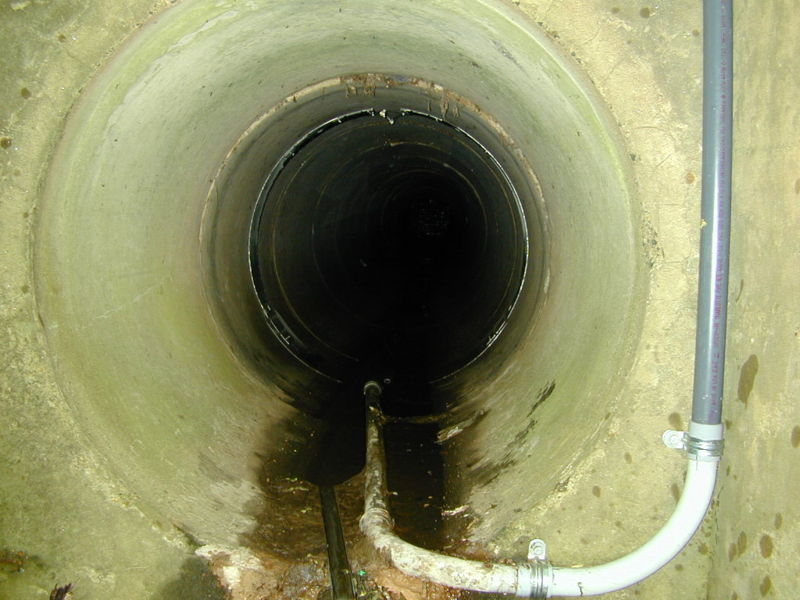Warning: My beta reader has referred to the monster of this post as “okay, like, legit disgusting.” If you are eating or are easily disturbed, you might want to sit this one out.
On April 27, 2009, the town of Raleigh, North Carolina contracted South Carolina-based Malphrus Construction to pilot a robotic surveillance camera into the sewers under Cameron Village. They were, they claimed, looking to take a survey of the sixty-year-old system, which had been struggling with infrastructure issues. Later it came out that the company might actually have been looking for a discarded weapon, but once the camera got down below the surface and shined its light into the black, filthy pipes, everyone forgot about that in a hurry.
Imagine, if you will, inching through those conduits: shadows at your back, shadows just beyond the reach of your light. The pipe is small enough that your eyes are nearly at its ceiling, which is speckled with the type of debris one might expect to find in a sewage conduit. Brown water flows steadily over your feet, only to disappear into the darkness ahead. You come across a seam in the pipe that is not as flush as it should be, and cannot fail to notice that there is something bulging out of it, just above the stream of the water.
It is pink and black, bulbous, with tendrils like blood-poisoned veins stretching out to cling to the wall. Sinewy and visibly slimy, at the touch of your light it shudders and retreats back into the crack, but only a little. It ticks, retracting, and shudders again. Horrified, you try to move forward, only to find two more straight ahead, facing each other across the sides of the tunnel. They sit quietly until you approach, and when you do, retract and retreat again, fighting their own weight, away from the shine of the light.
Think I’m embellishing? Take a look at the video.
When the footage hit the web, many doubted its authenticity. How could such a horror be real? Assuming that it couldn’t, everyone slept a little better. Then Marti Gibson, the Environmental Coordinator for Raleigh Public Utilities, confirmed that it was. She wrote in addition to i09 and urged people not to worry; the creatures were nothing but slime molds–repugnant, but not worth a panic.
Then, a few hours later, Gibson abruptly retracted that, calling the blobs a collection of worms and stating that regardless, the city of Raleigh was not responsible for the things discovered by a private contractor.
Now it was early July. In the span of four days, the video of what lurked under Cameron Village had been viewed 4.7 million times. Exasperated commenters assured their less well-informed peers that the blobs were just worms–tubifex worms, in fact, the type that people use to feed their fish. Ed Buchan, with the comforting heft of an environmental coordinator position at the Public Utilities Department, assured folks that the tubifex theory made sense. Tubifex worms feed of off debris and are known to cluster in groups about a half inch to an inch in diameter, he said, and conjectured that they’d moved in response to the heat of the light. These worms, he stated, were not dangerous to the water system–were completely harmless. No need to panic.
Biology professor Thomas Kwak at North Carolina State University disagreed. They could not be worms, he said, giving voice to investigators skeptical that Tubifex worms could appear as uniform as the creatures in the pipes did, or move and pulse as one like the blobs had, or never show up individually in the video on or around the mass itself. More likely they were bryozoans, creatures that feed off bacteria, thrive in the dark, and are commonly found both in sea and freshwater environments. But these, he assured everyone, were also harmless. Though they could grow to be the size of a watermelon, they need not be removed from the tube.
Doctor Timothy Wood, bryozoan expert of Wright State University, threw the ball back yet again:
So the creatures were not bryozoans. And so, the intrepid observer might ask, if they were not those, but also might not have been tubifex worms, what could they be?
An excellent question, and one that seems to have been hastily avoided. Many considered the case closed with the final tubifex argument, but the issue of the blobs appearing to be uniform–without any spare worms around–was never addressed. Nobody went in to take a sample to settle the matter. Nobody pointed out other, less tidy options–the ones you and I might be thinking of now.
Everyone did agree, however, that they wouldn’t take responsibility, and that we really shouldn’t trouble ourselves to go back and bother the creatures again.

Courtesy of Wikimedia Commons.
Would you?
Featured image by Kevin Andre.





0 Comments